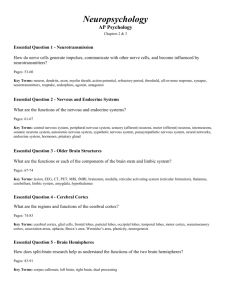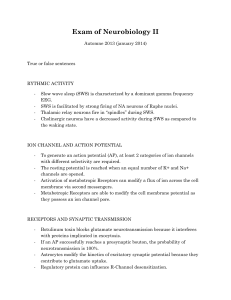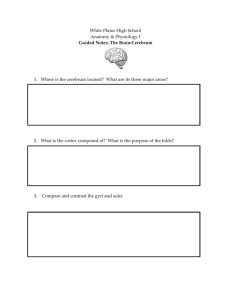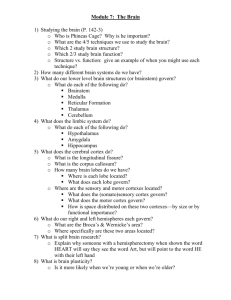mspn5a
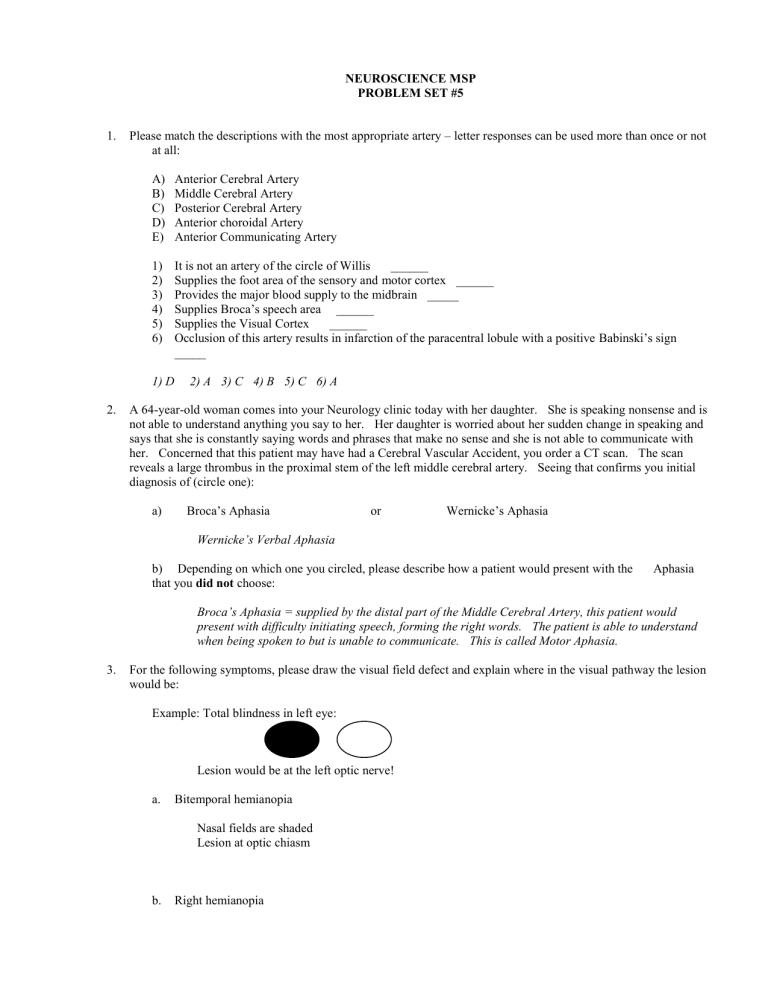
NEUROSCIENCE MSP
PROBLEM SET #5
1.
Please match the descriptions with the most appropriate artery – letter responses can be used more than once or not at all:
A) Anterior Cerebral Artery
B) Middle Cerebral Artery
C) Posterior Cerebral Artery
D) Anterior choroidal Artery
E) Anterior Communicating Artery
1) It is not an artery of the circle of Willis ______
2) Supplies the foot area of the sensory and motor cortex ______
3) Provides the major blood supply to the midbrain _____
4) Supplies Broca’s speech area ______
5) Supplies the Visual Cortex ______
6) Occlusion of this artery results in infarction of the paracentral lobule with a positive Babinski’s sign
_____
1) D 2) A 3) C 4) B 5) C 6) A
2.
A 64-year-old woman comes into your Neurology clinic today with her daughter. She is speaking nonsense and is not able to understand anything you say to her. Her daughter is worried about her sudden change in speaking and says that she is constantly saying words and phrases that make no sense and she is not able to communicate with her. Concerned that this patient may have had a Cerebral Vascular Accident, you order a CT scan. The scan reveals a large thrombus in the proximal stem of the left middle cerebral artery. Seeing that confirms you initial diagnosis of (circle one): a) Broca’s Aphasia or Wernicke’s Aphasia
Wernicke’s Verbal Aphasia b) Depending on which one you circled, please describe how a patient would present with the Aphasia that you did not choose:
Broca’s Aphasia = supplied by the distal part of the Middle Cerebral Artery, this patient would present with difficulty initiating speech, forming the right words. The patient is able to understand when being spoken to but is unable to communicate. This is called Motor Aphasia.
3.
For the following symptoms, please draw the visual field defect and explain where in the visual pathway the lesion would be:
Example: Total blindness in left eye:
Lesion would be at the left optic nerve! a.
Bitemporal hemianopia
Nasal fields are shaded
Lesion at optic chiasm b.
Right hemianopia
Temporal fields are shaded
Left optic tract lesion c.
Right upper quadrantanopia
Right visual field shaded in upper quadrant
Lesion at Meyer’s Loop d.
Left hemianopia (please use a different area than b)
Left visual field shaded
Lesion at right visual cortex
4.
a) How do the neurotransmitters differ between Pyramidal Cells and Non-Pyramidal Cells?
Pyramidal cells are the main projection/output neurons of the cerebral cortex – they have excitatory actions at their sites of termination such as glutamate
Non-pyramidal cell axons remain in the cerebral cortex – they are either interneurons or local circuit neurons.
These neurons utilize GABA, which is an inhibitory neurotransmitter used to control the level of excitability of the output neurons. b) Describe the cellular organization of the cerebral cortex (layers I – VI). Please include the functions of III – V.
I = Molecular layer – made up of pyramidal and non-pyramidal dendrites, very few cell bodies
II = External Granular Layer – predominantly non-pyramidal granule cells
III = External Pyramidal Layer – predominantly pyramidal cells
*function – project to the cerebral cortex of the opposite hemisphere
IV = Internal Granular Layer – predominantly non-pyramidal granule cells
*function -
V = Internal Pyramidal Layer – predominantly pyramidal cells
*function – project primarily to subcortical regions – striatum or spinal cord
VI = Multiform Layer – wide variety of cell types c) Where in the cortex is layer IV most abundant? And layer V? Considering the different make up of cell types, why do you think the cortical layers are distributed in this fashion?
Layer IV is most abundant in the sensory cortex. Layer V is most abundant in the Motor cortex. Layer IV contains predominantly granule cell, which are the primary receptive interneurons, once receiving afferent input they will project to other layers and areas of the cortex. Layer V contains predominantly pyramidal cells, which are the primary efferents of the cortex. These pyramidal cells will have their affect on the descending motor pathways.
5. a) Name the structures that are a part of the limbic system.
The limbic association cortex, which includes the parahippocampal and cingulate gyri.
The hippocampus and fornix.
The amygdaloid complex and stria terminalis.
Additional structures now considered a part of the limbic system include the nucleus accumbens, septal nuclei, mammillary bodies, parts of dorsal thalamus, habenular nuclei, ventral tegmental nuclei, periacquaductal gray, and possibly parts of the prefrontal cortex. b) What are some of the functions of the limbic system?
From page 2 of the handout, these structures "play important roles in memory, emotion, control of visceral function, and olfaction. Indeed, these parts of the brain help determine who we are - our memories, our unique personality, and our thoughts. Thus, it might not be surprising that many psychiatric disorders are considered to involve dysfunction of the parts of the limbic system." c) The bilateral removal of the amygdala and the surrounding cortex in primates produces a set of behavior changes collectively known as Kluver-Bucy syndrome. Please describe the changes in the animal after the bilateral removal.
Previously wild monkeys become tame and easy to handle. In broad terms, the animal is unable to relate sensory information to past experience and thus has a hard time evaluating the significance of sensory stimuli.
6. a) The two major inputs to the hippocampal formation are the entorhinal cortex and the septal nuclei. Please draw out and describe the trisynaptic pathway that originates from the entorhinal cortex (filling out the diagram on page 7 of your handout is a good start).
Students should understand the information on page 6 of the handout and be able to fill in the diagram on page
7 of their handout. b) Please describe the pathway originating from septal nuclei input.
From page 6 of the handout, "A second pathway of the hippocampal formation is from the septal nuclei to both the dentate gyrus and the hippocampus. Much of the information eventually reaches the subiculum, and the myelinated axons from both hippocampal and subicular neurons form the alveus on the external surface of the hippocampus; the axons are then assembled in the fimbria and proceed through the fornix to the mammillary bodies, thalamus, and back to the septal nuclei.
7. a) Certain pathological conditions primarily affect specific types of neurons in the hippocampal formation. Temporal epilepsy is one such condition. Describe the typical cell loss pattern seen with this CNS disorder.
Severe cell loss is seen in CA1 field, CA3 field, and the polymorph layer of the dentate gyrus. In contrast, the granule cells of the dentate gyrus and the neurons of the CA2 field are well preserved. b) Now describe the pattern seen in Alzheimer's disease.
The entorhinal cortex and CA1 field contain a large number of altered neurons and processes. Changes include neurofibrillary tangles that are made of abnormal bundles of neurofilaments, and neuritic plaques that are made up of deteriorating axons and dendrites in the neuropil. c) Which field of the hippocampus is prone to damage during ischemia when oxygen supply to the brain is compromised? Describe possible mechanisms of rapid and delayed toxicity, as well as the neurotransmitter-receptor systems involved.
The CA1 field is particularly prone to damage. Possible mechanism is the buildup of glutamate neurotransmitter during ischemia. This could be due to either increased release or decreased re-uptake during
hypoxia. Rapid toxicity is due neuronal depolarization leading to influx of Na and Cl, leading to cell swelling and lysis. Delayed toxicity is due to calcium buildup in neurons. NMDA receptors are excited by glutamate and are permeable to calcium and may serve as a substrate for this delayed toxicity. The whole phenomenon is known as excitotoxicity. See pages 10-11 of handout.
8. a) In your own words describe what is meant by neuronal plasticity.
Neurons in the CNS, as far as we know, do not regenerate. No new cell bodies are formed and axons do not re-form over long distances. However, there is axonal reorganization. Axons which have lost their targets can find new targets. Also, neurons that have suffered deafferentation, i.e. have lost incoming axons, become targets for other axons. See page 12 of handout. b) Keeping neuronal plasticity in mind, describe a possible series of events that might account for the changes seen in the hippocampus of a patient with intractable temporal lobe epilepsy.
Polymorph neurons normally innervate the inner molecular layer of the dentate gyrus. These polymorph neurons, along with CA3 neurons, become depleted with temporal epilepsy. Therefore, granule cells have lost some of their sites of termination. The loss of polymorph neurons also leads to vacated synaptic sites in the molecular layer. Granule cells may therefore send their axon collaterals to the inner molecular layer to innervate the vacated sites. This can result in abnormal circuitry that could lead to hyperexcitability and synchronization, leading to epileptic-like activity. See diagram on page 14.




